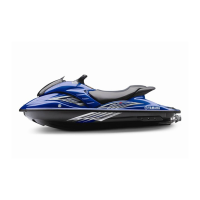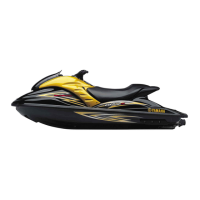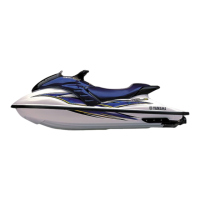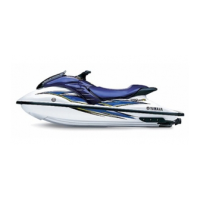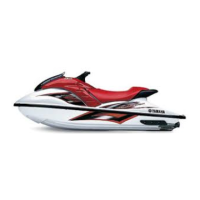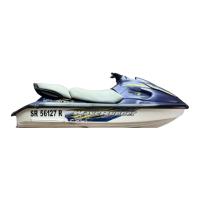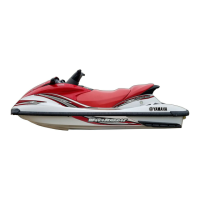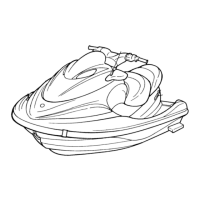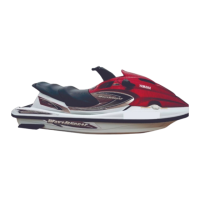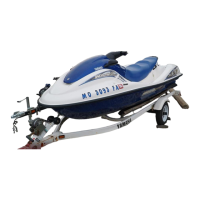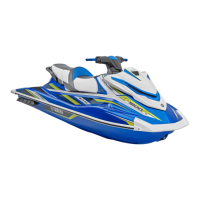Do you have a question about the Yamaha GP1300R WaveRunner 2003 and is the answer not in the manual?
Explains how to interpret symbols like WARNING, CAUTION, and NOTE in the manual.
Details on PRI-ID, HIN, and engine serial numbers for identification.
Location and explanation of various labels on the watercraft.
General safety rules, limitations, and hazard information.
Age, supervision, and training requirements for operating the watercraft.
Guidelines for safe operation, speed, visibility, and environmental conditions.
Requirements for personal flotation devices (PFDs), protective clothing, and eye protection.
Discusses the pros and cons of wearing a helmet for recreational riding.
Instructions on attaching and using the engine shut-off cord for safety.
Lists essential items to carry on board for safety and signaling.
Information on hazards like exhaust fumes and hot surfaces.
Explains the jet thrust propulsion and Off-Throttle Steering (OTS) system.
General rules for operating on waterways and interacting with other vessels.
Explains the lateral system of buoyage and common markers.
Provides contact information for boating safety resources and education.
Emphasizes responsible operation, respect for others, and environmental protection.
Identifies the primary physical components of the watercraft.
Details the operation of various controls and functions on the watercraft.
Identifies key components located within the engine compartment.
Instructions for removing and installing the watercraft seat.
Instructions for opening and closing the watercraft hood.
How to remove and secure the fuel tank filler cap.
How to remove and secure the oil tank filler cap.
How to use the start switch to begin engine operation.
How to check the cooling system operation via pilot outlets.
Explains how the handlebars control the jet thrust nozzle for steering.
How to use the QSTS selector to adjust the trim angle of the watercraft.
Effect of bow down trim on handling, turning, and speed.
Effect of bow up trim on handling, acceleration, and speed.
Function of the handgrip for boarding the watercraft.
How the overheat warning system functions and what to do if it activates.
How the exhaust temperature warning system functions and actions to take.
Overview of the YEMS, controlling timing, fuel, diagnostics, and OTS.
Details the functions and displays of the multifunction information center.
Explains the tachometer display and its increments.
How the speedometer displays watercraft speed and unit switching.
Explains the fuel meter segments indicating fuel level.
How to switch between hour meter and voltmeter displays.
Indicates when the fuel level is low and the associated warnings.
Signals low oil level or clogged oil filter, with actions to take.
Indicates engine malfunctions detected by sensors or circuits.
Information on the front and glove compartments, including capacity and load limits.
How the adjustable sponsons affect performance and how to adjust them.
Information on the types of fuel and oil required for the watercraft.
Safety precautions and guidelines for refueling gasoline.
Specifies the recommended oil and precautions for its use.
Step-by-step instructions for safely filling the fuel tank.
Step-by-step instructions for safely filling the oil tank.
A comprehensive checklist of items to inspect before operating the watercraft.
Procedure for ventilating and inspecting the engine compartment.
How to check the fuel and oil systems for leaks and levels.
How to check for and drain water from the water separator.
How to check for and remove water and fuel residue from the bilge.
How to inspect the battery condition, leads, and breather hose.
How to check the fire extinguisher and its container.
How to check the operation and return of the throttle lever.
How to check for looseness and smooth operation of the steering.
How to check the jet intake for debris or restrictions.
How to check the start, stop, and shut-off switches for proper function.
Explains the importance and procedure for breaking in the new engine.
Step-by-step guide on how to start the watercraft engine safely.
How to properly stop the engine, including safety warnings.
Advice on gaining skills and familiarizing with the watercraft before operation.
Guidance on pre-operation checks and learning safe riding techniques.
How operating with a passenger differs and safety considerations.
Procedures for starting and boarding in shallow water conditions.
Procedures for starting the watercraft when docked.
Step-by-step guide for boarding the watercraft by yourself.
Step-by-step guide for boarding the watercraft with a passenger.
Procedures to follow if the watercraft capsizes to prevent damage or injury.
How handlebar position and throttle affect turning performance.
How to stop the watercraft, acknowledging it has no brakes.
How to safely bring the watercraft to shore and beach it.
How to safely approach and dock the watercraft.
Precautions for operating in rough water or jumping waves.
Procedures for checking and cleaning the watercraft after use.
Guidelines for storing the watercraft, including seasonal storage.
Procedure for flushing the cooling system to prevent clogging.
Lubrication points and procedures for cables and other moving parts.
Maintenance procedures for the fuel system, including adding stabilizer.
Maintenance and care for the watercraft battery.
How to clean the watercraft after use or for storage.
Overview of periodic inspection, adjustment, and lubrication tasks.
Importance of carrying the manual and tool kit, and where they are stored.
A chart outlining recommended maintenance intervals and tasks.
How to inspect the fuel system for leaks, cracks, or malfunctions.
How to inspect the oil injection system for leaks and malfunctions.
How to check and adjust the jet thrust nozzle angle for proper steering.
How to check and adjust the throttle cable free play.
How to check the QSTS selector, shift lock lever, and nozzle movement.
How to clean, gap, and install spark plugs for optimal engine performance.
Identifies specific points requiring lubrication with water-resistant grease.
States that the fuel injection system is factory-set and should not be adjusted.
How to check and verify the correct trolling speed.
How to replace fuses in the electrical box with correct amperage.
Procedure for bleeding the oil injection pump if it becomes empty.
Guide to identifying and resolving common watercraft problems.
A table listing common troubles, possible causes, and remedies.
Procedure for clearing weeds or debris from the jet intake and impeller.
How to jump-start the watercraft battery using another battery.
Guidelines and precautions for towing an inoperative watercraft.
Steps to take if the watercraft becomes submerged or flooded.
Details the terms and conditions of the watercraft warranty.
Information about Yamaha's extended service plan for owners.
| Manufacturer | Yamaha |
|---|---|
| Model | GP1300R WaveRunner |
| Year | 2003 |
| Displacement | 1296 cc |
| Fuel Type | Gasoline |
| Fuel Capacity | 18.5 gallons |
| Oil Capacity | 3.2 quarts |
| Cylinders | 3 |
| Cooling System | Water-cooled |
| Starting System | Electric |
| Lubrication System | Oil injection |
| Hull Material | Fiberglass |
| Pump Type | 155 mm Axial Flow |
| Impeller Rotation | Counterclockwise |
| Steering System | Handlebar |
| Category | Personal Watercraft |
| Engine Type | 2-stroke |
| Seating Capacity | 3 |
